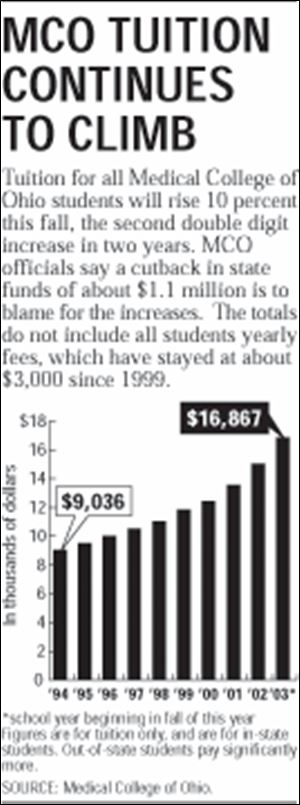
MCO board votes 10% fall increase
3/25/2003
Tuition for all Medical College of Ohio students will increase 10 percent this fall, a year after an 11 percent increase that was the largest in school history.
MCO officials say state cutbacks of $1.1 million in the last year are to blame for the increases. The tuition increases should make up for all of the state cutbacks.
“It's frustrating for the board, but unfortunately it's an economic reality. Our hands are tied,” said Lillian Walsh, president of the MCO board of trustees, which approved the increases unanimously last night.
That's little comfort to medical students like Matthew Herron, a first-year student from Lisbon, Ohio.
“I have no sugar daddy who can pay for everything. My parents are schoolteachers,” Mr. Herron said. “I'm going to graduate with $150,000 in debt, even spending conservatively. This is really disheartening.”
Dr. Amira Gohara, acting MCO president, said the increases will affect all MCO students beginning in August. MCO has 569 medical students, 117 graduate students, 128 nursing students, and 191 allied health students.
Medical students pay the most by far.
This fall MCO medical students will pay $16,867 in tuition, an 87 percent increase since the 1994-95 school year. The tuition totals don't include yearly fees of $3,092 that all students must pay. Fees have stayed relatively stable since 1999.
“If we could get the support from the state we need, we wouldn't have to do this, but we don't have other choices,” Dr. Gohara said.
Dr. Gohara said medical schools across the country share MCO's predicament, and other Ohio medical colleges are bound to also raise tuition. MCO is the first Ohio medical school to announce its tuition for next fall.
Officials at the state's other five medical colleges were contacted, and most said although they haven't estimated this fall's tuition, increases are certain.
“It's real sad. At the financial aid office, our goal is for every student to have as low a debt as possible, so this raising tuition has been very unfortunate,” said Carol Bussey, financial aid coordinator at the Wright State University School of Medicine in Dayton, which raised tuition twice last year.
Some medical experts have said skyrocketing medical school tuition could cause students to avoid lower-paying specialties like family practice and choose more lucrative fields. Many parts of the country are already experiencing shortages of physicians in some key areas.
Dr. Gohara said that hasn't happened at MCO yet. She said 41 percent of this year's graduating class of MCO medical students chose a primary care residency program. Ms. Bussey of Wright State added that most medical students are resigned to the fact that they'll have larger and larger tuition bills.
“Medical school is so hard to get in to, and they know it's pricey. As long as they get in, they're usually happy,” she said.
Mr. Herron, 22, isn't so sure.
He said his Christian faith motivated him to help others, and he decided becoming a physician was the best way to serve people and God.
Mr. Herron said his goal was to become a physician and travel as a medical missionary. He worries that his mounting debt will make it difficult to choose that path.
But he acknowledges that when he speaks with older classmates they tell him not to worry. “They're used to it,” he said. “They just say, `What's another $30,000? It's just another five years of debt.'”